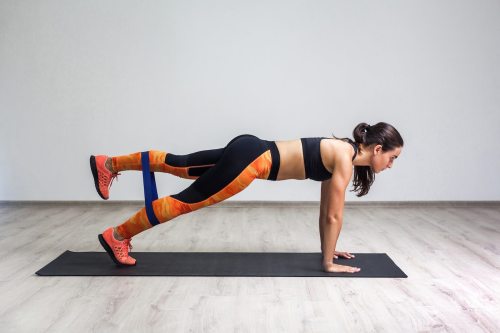A fun fitness fact that you’ve likely realized during your workouts: One side of your body tends to be a little stronger than the other. In most cases, it’s totally normal and fine, and just means that lifting a 20-pound weight on your right might be a little easier than doing it on your left. But muscle imbalances in your glutes, which are very common, can lead to pain and even injury.
In fact, the majority of people are dealing with some sort of imbalance in their behind, and it’s got nothing to do with their workout routines. “If you have a sedentary occupation—which 80 percent of people do—you can guarantee that your glutes are under active,” says Steve Stonehouse, NASM, director of education for Stride. “Along with being under active, there’s a high likelihood you have some glute imbalance as well.”
This, pros caution, can lead to a slew of issues throughout your body. “You could deal with a host of injuries tied to these type of imbalances,” says Stonehouse. “The kinetic chain concept basically states that nothing works in isolation. A nagging knee injury could be more of a hip/glute issue than an actual knee issue. The same applies with the ankles or even shoulder issues.” Glute imbalances can even be causing you lower back pain, which no one wants to deal with.
To find out for sure if this applies to you, Jackie Vick, NCFS, Gold’s Gym personal trainer, suggests testing yourself with unilateral and bilateral movements. “For a unilateral, try a single-leg deadlift. Did one hip rotate? For a bilateral, try a squat and see if there’s a shift in the hips. Is one lower?” she says. If you answered “yes” to all of the above questions, it’s a good idea to work on balancing your butt muscles to avoid problems down the line.
First, Stonehouse suggests figuring out what’s causing the imbalance. “Ninety percent of the time, an imbalance is caused by the opposing muscle being overactive,” he says. In the case of your glutes, that would be your hip flexors “That causes what’s called an altered reciprocal inhibition, where one muscle is preventing another muscle from doing its job properly.” In this sitch, you can address the problem with a kneeling hip-flexor stretch.
To get to the glutes themselves, Vick recommends isometric work. “The best exercises for balance are all about loading the weaker glute,” she says. “Focus on isometric contractions that get the weaker side firing correctly,” adds Stonehouse. Keep scrolling for the glute-balancing exercises to try to—ahem—round out the muscles in question.
1. Single leg raises: Vick recommends doing single-leg raises. Hold three seconds before releasing to the next step.
2. Fire hydrants: Raise one leg out to the side from a quadruped position. Hold at the top for three seconds.
3. Clam shells: Lie on one side, with the weaker glute on top. Raise the top leg to lift into a clam shell. Hold three seconds before releasing.
4. Banded side steps: “Stay low in a quarter of a squat and step 10 to 20 steps, then rest,” says Vick. Repeat two to four times.
5. Glute bridge: Stonehouse recommends doing a set of bridges before a leg workout to get your glute muscles properly firing. Do 10 reps of 10 second holds while squeezing your glutes as tightly as possible.
Oh, and here’s what to know about yoga butt, another glutes-related muscle imbalance. Also useful: This dynamic hamstring stretch called the “waterfall” to open up your legs after all that glute work.
Sign Up for Our Daily Newsletter
Get all the latest in wellness, trends, food, fitness, beauty, and more delivered right to your inbox.
Got it, you've been added to our email list.











